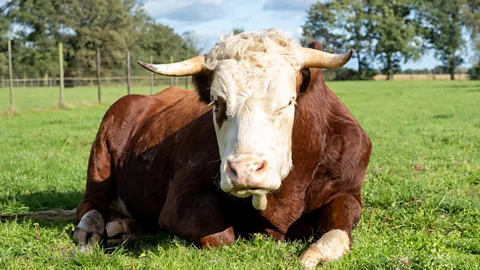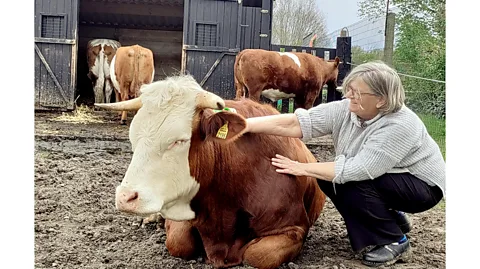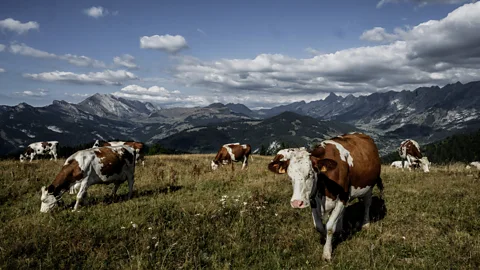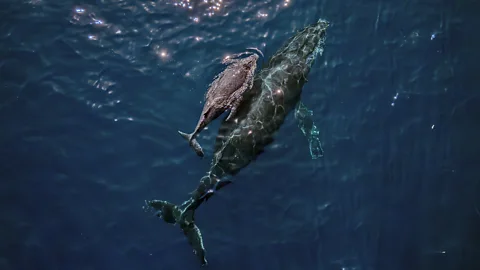 Henk van de ven/ leonie cornips
Henk van de ven/ leonie cornipsDutch linguist Leonie Cornips is fascinated by the way cows communicate. But can it really be called ‘language’?
Leonie Cornips was too late for her coffee break. Autumn cold air made a hot drink felt attractive. But the cornips was busy. She was a couple of hours in her work with a small herd of milk cows. If she left now, she would lose something that would take time to recover. Cornips and Tufa had entered a delicate, common space she calls “cow’s rhythm”.
Cornips is a sociolinguist in Institute Meertens in Amsterdam in the Netherlands. Researchers passing through the ornamental entrance of the institute usually specialize in the study of Dutch language and culture. The soft -words researcher won her academic laurels in the 1990s, and she still studies changes in syntax between different dialects in the Netherlands. But in addition, the work of Cornips has recently received what professionals in the field call “Animal curve“
For years, Cornips has spent her summer vacation on a farm. It was hit from the beginning by different personalities of individual cows. it Read an essay From a philosopher who asked why linguists never study animals. Touched it deeply. Cornips thought that cows had intelligence and social customs to be good research subjects for a linguist. As a Dutch person, she also knew they were cultural icons in a nation with a passion for cheese. So she returned her professional skills to the cows.
 Henk van de ven/ leonie cornips
Henk van de ven/ leonie cornipsPeople have been assumed for centuries that the ability to use language is a measure of our superiority. There is also an academic term for: “logocentrism”, which means those who use words (from Greek LOGOwhich means “word” or “reason”) occupy a privileged position. Language, say a lot of linguists, is What does it make us human. Animals can accumulate, peel or chirp, but they possess nothing that is counted as language.
Cornips is using her milk cow’s work to postpone this idea again. Lies half a century effort that began with Jane Goodall’s work with shimpanzees and Roger Payne’s registration of bumpy whales In the 1960s in an attempt to show that people may not be as unique linguistic as we had assumed.
Many of Cornips colleagues were skeptical when she suggested that they implemented the animal linguistics framework.
“The problem is that people have no clear idea of language,” she says. “When they talk about language, they always refer to what comes out of the mouth.” But after spending six years completely immersed in the life of cows, Qornips thinks the language is better understood as “scattered” Between the mouth, body and surroundings, making it embodied, multi-modal and sensory. “I’m eating with cows, touching, kissing, walking, hugging,” she says.
Cornips and farmers she recruits to help record the frequency, duration and intensity of the sounds that cows make. But it also focuses on other ways that the meaning is expressed between bovine. Its methods are often ethnographicA way to study cultures that is strongly supported by the researcher. Cornips carefully observes the behaviors and interactions of the cow along with the sound to determine how they communicate. “I notice with cows that the body is an instrument to know the other,” she says. Knowing this leads the corps to speak less about “language” and more widely of “language practices”.
The cows, for example, have a detailed greeting ritual that the frames must follow to slide successfully in the clutch rhythm, she says. This became visible to Piet, a young Horstein male from an intensively managed home structure, which brought to join five other cows in an outdoor pasture.
“I was always so happy that I saw him, that when I got into his meadow, I walked towards him and tried to touch him immediately,” Cornips says. When she did this, Piet would be withdrawn.
Cornips gradually came to understand the need to respect the personal space of drinks, as she can with another man. She learned to hold her arms near her sides and only use intermittent eye contact, taking the curves with the pirate to see each other and then look away. “It took me a long time,” she says. “I was too stupid. They’re teaching me how to connect with them.” Cornips realized that she had to learn a label. Without patience and attention, she says, you would never see it.
Patience also turns out to be essential when cows communicate with each other. When a mother calls her calf, sometimes it takes 60 seconds for the beef to respond. The space between is filled with body gestures. Studies from Austria show That ear positioning and neck extension are integral for the cow’s language. People think about the ability to shake our ears as a party trick. For a cow, it seems to be essential for communication. The first sentence in a conversation with a cow is likely to include the movement of the ears and a look.
Cows are not the only animals that are studied for their complex ways of communication. Michelle Fournet, a professor specializing in maritime acoustic ecology at the University of New Hampshire in the US, has learned that it is useless to impose human expectations for species such as whales and seals.
 Getty Images
Getty ImagesFournet stops using the word “language” to describe the transfer of information that is happening between non-surgery. But she has gained an in -depth appreciation for the details of animal communication. Their system is no less than ours, says Fournet but other. We make them a concern seeking similarities.
A difference between humans and many animals is their use of the environment. Cornips has found cow’s communication rests on its surroundings More than ours. She observed a herd where individuals used their bodies to hit on an iron fence to communicate with the rest of the herd at the time of feeding, which she looks at as type. She noticed cows responding to her differently depending on whether she entered a solid wall barn or open sides: Since cows on different farms are surrounded by different physical characteristics, this offers distinctive opportunities for linguistic expressions . Cows, she argues, develop different language practices – almost like dialects – where the meaning depends on the shape of their surroundings.
Like other pets, cows face the additional challenge of communicating interspecies with humans. “Most farmers are not sensitive to cow rhythm,” says Cornips. “Cows must obey the rhythm of the farmer.” Milk bundles are constantly disappearing between food, milking and pastures. If a cow does not learn the daily routine or fails to be productive, it goes to the slaughterhouse. It is shocked by the way people easily assume that cows are stupid.
“By becoming a cow of milk,” she says, “they must have very rich communication skills because they have to understand what you want the farmer to do … which is not easy.”
Cornips has analyzed recordings to indicate that cows will Simplify their vocalization As a farmer recognizes their need. Instead of educating their intelligence from them to be more compatible, frames think that pets are forced to develop a fuller repertoire of communication than wildlife.
But Cornips indicate that whales lack some of the capacities of cows. The ears of a whale are not as mobile as a cow, she says. They also lack hooves. “Whales cannot express many bodies,” Cornips says. “[In] That way they can be more primitive than cows. “
 Getty Images
Getty ImagesFournet says she does not believe that it makes sense to list the communication of animals with its complexity. “There is no answer to what you are looking for,” she told me when I asked her to compare whales with cows.
Many traditional linguists are still hesitant to attribute the non -human language. Leora Bar-EL, a professor of linguistics at the University of Montana in the US, is not hostile to the idea of animal language, but thinks it is worth asking what we earn and what we lose by expanding the definition of language to include cows .
“We may miss the fact that there is something unique about human language,” she says. For example, the human language allows tremendous creativity. Think about Shakespeare’s works. It can also refer to distant events and even reflect again in itself, as the language does when providing a definition.
But Eva Meijer, author of essays that the first inspired cornepes And the 2018 Book Book Book argues that such claims can be self-fulfilling. “What we see as a language has been developed excluding the language of other animals,” she says. In fact, we define the language in a way that facilitates the denial of others. Meijer tells the long story of human oppression associated with the denial of other people their language. She believes that knowledge of language in animals provides new tools to understand them and possibly even to learn how to dwell on the most sustainable plans.
Cornips, however, does not place an animal rights agenda at the center of its work. It is mainly focused on expanding the field of linguistics. But implications are difficult to ignore. Cows can have more complex social lives than we thought. Its research reveals numerous additional ways of exploration. How much does language contribute to bovine communities and distinctive culture? Sort what kind of planning can cows do with each other? Can they use languages to overcome knowledge between generations?
The answers to these questions can change how we consider the lives of many animals. When is 96% of mammal weight on the ground made up of people and household cattleBetter understanding what cattle, sheep and chickens are communicating can lead to improved relationships with them, as well as better animals for animals.
Cornips know that things are unlikely to change quickly. Recently, however, she has noticed the idea that animals have made tongues have been made The most common in academic journals.
She hopes linguistics can be a means of unlocking different attitudes. “My most important goal,” she says, “is to tell others that you can see with different eyes in a pet.”
For more science, technology, environment and health stories from the BBC, follow us Facebook, X AND Instagram.
